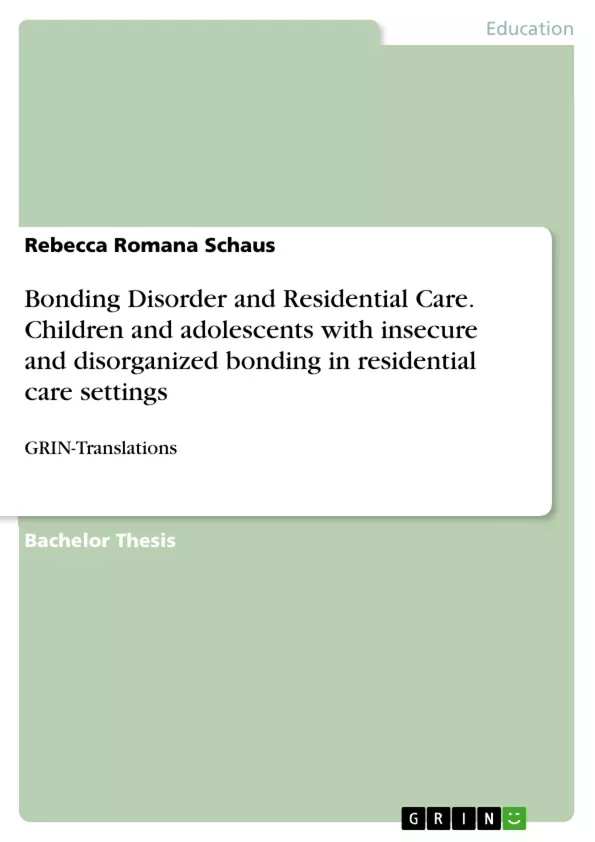This text was translated with the help of AI and reviewed by the GRIN editorial team.
Fundamental aspects of bonding theory should first be examined. Because without being aware of these theoretical foundations, bonding-sensitive action is hardly possible. Attention must also be paid to the framework conditions of home education. In recent years, especially in the type of housing, this has developed into a versatile aid for education. This also raises the question of which alternatives to classical residential groups can be found and whether these would not be more usefully suited for the accommodation of insecurely bound or traumatized children and adolescents.
However, it is also important to present the demands on the pedagogical specialists, which result from a paper based on bonding theory. Is it even possible to become a bonding person in everyday life at home? What qualifications are needed for pedagogical action? And what personal skills should specialists in home education have?
In order to understand the influence of early bonds on the development of the child, the bonding theory is theoretically presented in the second chapter of this thesis. Thus, aspects such as bonding, bonding behavior and the concept of the secure basis are explained as well as the emergence of the first bonding relationship and the inner working model. Afterwards, attention is paid to the bonding quality. The different types of bonding behavior are considered across the cv.
Chapter three is used to present various bonding disorders as categorized according to international statistical classification. However, since these groups are very general, this thesis will continue to refer to the diagnosis and typology of bonding disorders of the child and adolescent psychiatrist and psychotherapist Karl-Heinz Brisch.
The fourth chapter deals with the framework and legal foundations of home education. This provides an overview of various forms of care and living (partial) inpatient accommodation. The Child and Youth Welfare Act then serves as a basis for presenting legal framework conditions.
Inhaltsverzeichnis (Table of Contents)
- Introduction
- Bonding-theoretical foundations
- The bonding theory according to John Bowlby
- Bonding
- Bonding behavior
- The secure basis
- Bond development
- The inner working model
- Bonding quality
- Secure bonding
- The unsafe-avoiding bond
- The uncertain-ambivalent bond
- Disorganized/disoriented bonding
- The bonding theory according to John Bowlby
- Bonding disorders
- Classification of bonding disorders according to ICD-10-GM
- Diagnosis and typology of bonding disorders according to Brisch
- Home education
- Definitions of the terms home and home education
- Forms of care for home education
- Legal basis
- Bonding disorders and home education
- The role of the educator
- Pedagogical action depending on the different types of bonding
- On the correctability of internal working models
- Accommodation recommendation
- Dealing with children and adolescents who are insecure of bonding
- Dealing with unorganised children and adolescents
Zielsetzung und Themenschwerpunkte (Objectives and Key Themes)
This work explores the intersection between attachment theory and home education, focusing on the challenges of caring for children with insecure or disorganized attachment patterns. The text aims to provide a theoretical framework for understanding these challenges and to outline pedagogical strategies for supporting the emotional development of such children within a home environment.- Attachment theory and its implications for child development
- Types of attachment patterns and their corresponding behavioral manifestations
- The role of home educators in fostering secure attachments
- Pedagogical interventions tailored to different attachment styles
- The impact of early attachment experiences on later life outcomes
Zusammenfassung der Kapitel (Chapter Summaries)
- The first chapter provides an introduction to the topic, highlighting the importance of attachment for children's well-being and the specific challenges faced by children in care who have experienced insecure or disorganized attachment.
- The second chapter delves into the theoretical foundations of attachment theory, focusing on the key concepts of attachment, attachment behavior, the secure base, bond development, and the inner working model.
- Chapter three examines different types of attachment patterns, including secure, insecure-avoidant, insecure-ambivalent, and disorganized/disoriented attachment, and their implications for children's emotional and social development.
- The fourth chapter discusses the framework and legal foundations of home education, providing an overview of different care models and their legal bases.
- The fifth chapter explores the intersection of attachment theory and home education, examining the role of home educators in fostering secure attachments and outlining pedagogical strategies for addressing different attachment styles.
Schlüsselwörter (Keywords)
This work focuses on the intersection of attachment theory, home education, bonding disorders, secure and insecure attachment, internal working models, pedagogical intervention, and the role of caregivers in fostering positive emotional development. The text explores how early attachment experiences influence the child's developmental trajectory and the potential for intervention within a home education setting.- Quote paper
- Rebecca Romana Schaus (Author), 2014, Bonding Disorder and Residential Care. Children and adolescents with insecure and disorganized bonding in residential care settings, Munich, GRIN Verlag, https://www.grin.com/document/1470321



